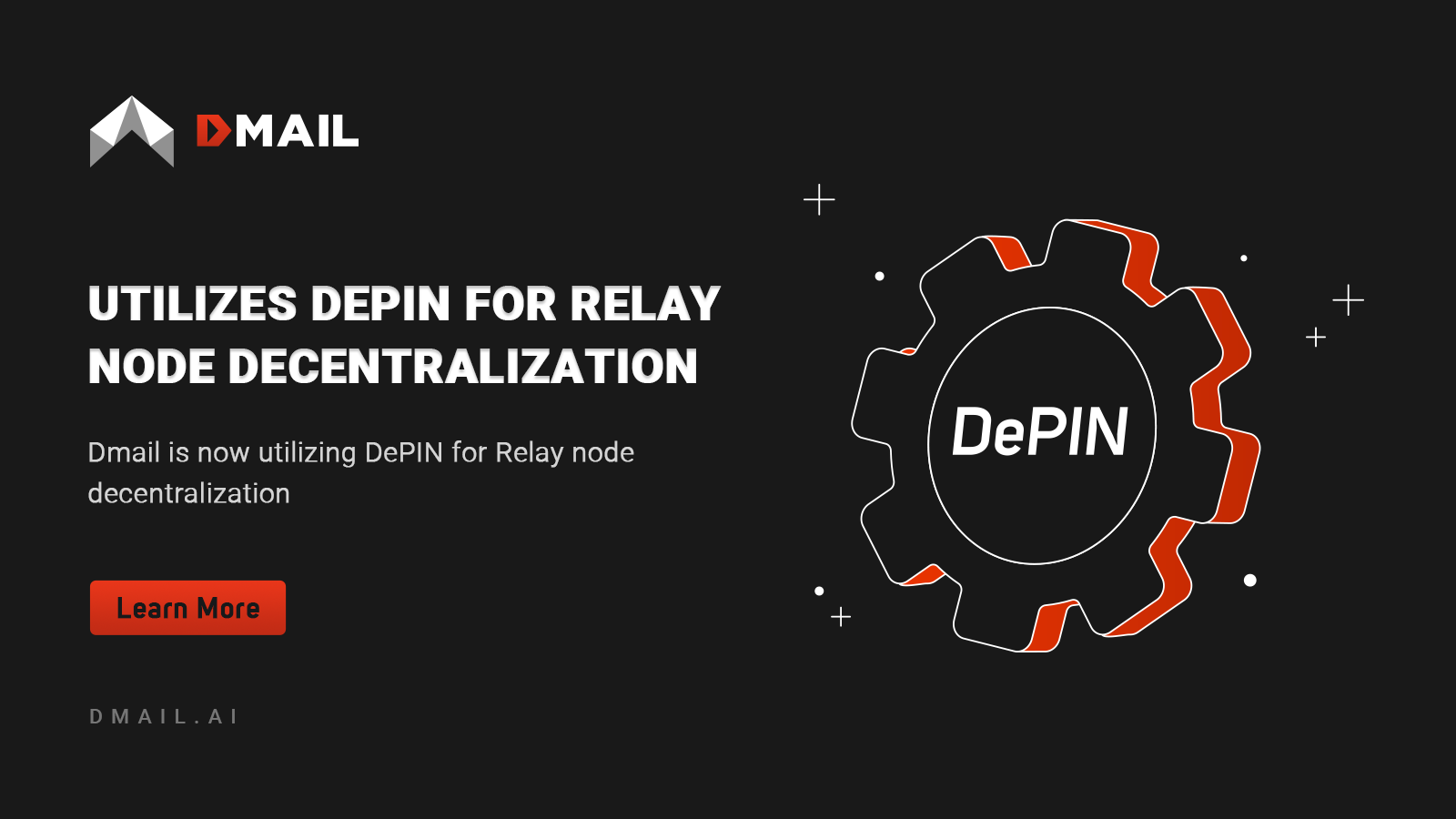Dmail Network Utilizes DePin for Relay Node Decentralization
Dmail is now utilizing DePIN for Relay node decentralization and has added this to the roadmap for Q2 2024 completion

Dmail Network Utilizes DePIN for Relay Node Decentralization
In the dynamic world of Web3, Dmail Network emerges as a trailblazer, employing Decentralized Physical Infrastructure (DePIN) to revolutionize its relay node infrastructure. This strategic use of DePIN will not just enhance the network's performance but is also a significant step towards achieving complete decentralization in communication.
Architectural Excellence in Dmail Network
The foundation of Dmail Network's success is its robust and meticulously designed architecture. The system comprises the user-friendly Dmail DApp at the application layer, coupled with a transport layer for developers that is optimized for the seamless transmission of messages. The infrastructure's pillars, including endpoints, relayers, and routers, ensure a secure, efficient, and reliable communication process.
Relays
Relays serve as the backbone of the Dmail Network, functioning similarly to backend servers. These pivotal components empower the Dmail DApp endpoints to transmit messages efficiently and ensure their broad dissemination across all connected endpoints over multiple chains. It's important to recognize the dynamic nature of the relay landscape within the Dmail Network. This ever-evolving domain is anticipated to undergo numerous enhancements, continually elevating the network's performance and capabilities.
It's worth noting that the Dmail DApp's decentralized nature inherently relies on these relays for the essential functions of data storage and retrieval. Consequently, if you ever encounter a slowdown in the responsiveness of your Dmail DApp endpoints, it's likely attributable to the performance of the relays in use. This highlights the integral role that relays play in maintaining the smooth operation of the Dmail Network and underscores the continuous efforts to optimize and evolve this crucial infrastructure component.
The Choice Between Default and Personal Relayers
For the majority of users, the need to operate a personal relayer is not necessary. The default service provided by the Dmail Network is designed to meet your needs efficiently, sparing you the complexity and expense of managing a relayer independently. However, for those who possess technical expertise and prioritize the utmost level of uncensorable communication, the option to run your own relay is available. By choosing to manage your relay, you gain complete control and ownership of your messages and data, ensuring a communication experience that aligns perfectly with the highest standards of privacy and autonomy.
Future Horizons: Expanding Access to Relayers in the Dmail Network
At present, the relayers integral to the Beta Testnet of Dmail Network are exclusively provided by our own network and a select group of trusted third-party service providers. While we understand the community's enthusiasm for open-source solutions, these are not yet available. However, rest assured, we are diligently crafting a comprehensive guide to navigate this terrain. Our aim is to roll out this guide concurrently with the launch of Dmail Network's mainnet, timing subject to the culmination of our development efforts.
Looking ahead, we are excited about the future prospects. You'll have the opportunity to deploy one of our open-source implementations on your personal servers, offering you an added layer of autonomy and customization.

Embrace Independence and Rewards with Dmail Native Token
In the Dmail Network, users and developers are not just participants; they are empowered contributors to the network's ecosystem. By independently running a relay, you not only gain mastery over your data sovereignty but also become an integral part of the network's operations. This empowerment is further sweetened by the rewarding opportunity to earn DMAIL native tokens.
As the network thrives on the principles of Decentralized Physical Infrastructure (DePIN), revenue generation stands as a pivotal aspect of its future growth. By engaging actively in the network and contributing to its robust infrastructure, you open up a stream of revenue for yourself, earning Dmail Native Tokens as a testament to your valuable contribution. Join the movement where your participation not only safeguards your data autonomy but also paves the way for a rewarding journey in the realm of DePIN.
Alternatively, for those seeking a more hands-off approach, the option to rent these services directly from established relay hosting services will also be available, ensuring flexibility and ease of use tailored to your specific needs. Stay tuned as we continue to innovate and expand the capabilities of the Dmail Network.
Multi-Chain Communication Process in Dmail Network
Dive into the sophisticated world of the multi-chain communication process, a hallmark of the Dmail Network. This carefully engineered process is designed to ensure that every message is transmitted securely, swiftly, and with utmost confidentiality. It upholds the integrity of interactions between the sender and recipient through the Dmail DApp, ensuring a seamless and private communication experience.

Sender's Interaction with Dmail DApp:
The communication process begins when the sender logs into the Dmail DApp. Catering to a diverse user base, the DApp supports login through an impressive array of 18 different chains as well as Worldcoin's WorldID and Web2 login via Google. This flexibility sets the stage for a seamless and inclusive messaging experience.
Message Encryption and Dispatch:
Once logged in, the sender embarks on the critical task of encrypting and dispatching their message. This involves:
a. Encrypting the Message: The message is first encrypted and then securely stored in a distributed container. This step also involves the creation of a unique message URI (Uniform Resource Identifier), marking the message for its journey through the network.
b. Packaging and Dispatching: Next, the sender's details, along with the recipient's information, subject, URI, and timestamp, are neatly packaged into a relay message. This message is then dispatched to the network's relayer system, poised for the next stage of its journey.
Relayer Verification and Broadcast:
At this point, the relayer system takes the helm. It starts by decrypting the sender’s smart contract and then broadcasts the message to all other connected endpoints across multiple chains. The system is composed of Source and Destination Message Buses, a Validator, and a Cross-Chain Message Executor, each playing a crucial role in processing the message. The Validator ensures the message's authenticity and distributes it, while the Executor is responsible for forwarding verified messages to the routing system.

Routing and Network Matching:
The router now steps in to ensure the message reaches its intended destination. It meticulously assesses the recipient's address format, aligns it with the message's unique ID, and then directs the message accordingly.
Web2 & Web3 Messages Distribution:
The distribution process is tailored to accommodate both Web2 and Web3 paradigms:
- Web2 Distribution: In this scenario, messages are decrypted by a proxy robot and then forwarded using conventional SMTP and email protocols.
- Web3 Distribution: Here, messages are directly sent to the validated ID and recipient address within the Web3 network, ensuring a seamless and integrated experience in the decentralized landscape.
Recipient's Engagement:
The recipient's interaction with the Dmail DApp is intuitive and secure. Although the system supports logins from multiple chains, message retrieval is currently optimized primarily through the Internet Computer. However, plans are underway to broaden this capability to encompass multiple chains, enhancing accessibility and convenience.
Messages Retrieval:
The final step in the communication process is the retrieval of messages. Once the recipient logs in, their network and address are transformed into a unique Dmail ID. This ID serves as the key to accessing incoming messages. Messages linked to the recipient’s ID are fetched from the distributed container using the message URI, decrypted, and then presented in their entirety, ensuring a comprehensive and confidential communication experience.
This multi-chain communication process is a testament to Dmail Network's commitment to providing a secure, efficient, and user-centric messaging solution in the ever-evolving Web3 landscape.
Strategic Partnerships Driving DePIN Innovation
Dmail Network's utilization of DePIN for relay node decentralization is further strengthened through strategic partnerships.
- Alliance with Phala Network: The collaboration with Phala Network in the DePIN domain is set to bolster the decentralization of Dmail’s relay nodes. Phala Network's proficiency in data storage, privacy computing, and advanced hardware is instrumental in the joint exploration and development of DePIN.
Dmail recently posted on X about the exciting cooperation!
🥳Dmail is delighted to reach strategic cooperation with @PhalaNetwork in the #Depin domain, enhancing Dmail’s messaging relay nodes' decentralization.
— Dmail Network (@Dmailofficial) January 16, 2024
🔥We will jointly delve into the progressive development of Depin, with Phala Network offering its expertise in data storage,… pic.twitter.com/h3f2RX5sgP
- Partnership with IoTeX: The strategic alliance with IoTeX in the DePIN space is a venture into the untapped potential of DePIN. This partnership signifies the integration of Dmail as a DePIN representative within the IoTeX ecosystem, leveraging their extensive experience to foster innovation and development in DePIN.
IoTeX used their Subscription Hub channel on Dmail to announce to over 100,000 subscribers about the fantastic news.

These partnerships don't just symbolize collaboration; they represent a unified commitment to a decentralized future, where DePIN is an integral component of our digital infrastructure.

Join us at Dmail Network as we lead the charge in utilizing DePIN for relay node decentralization, setting new standards for secure, efficient, and decentralized communication in the Web3 era.

Connect with Dmail: Website | Twitter | Discord | Github | Telegram





Comments ()